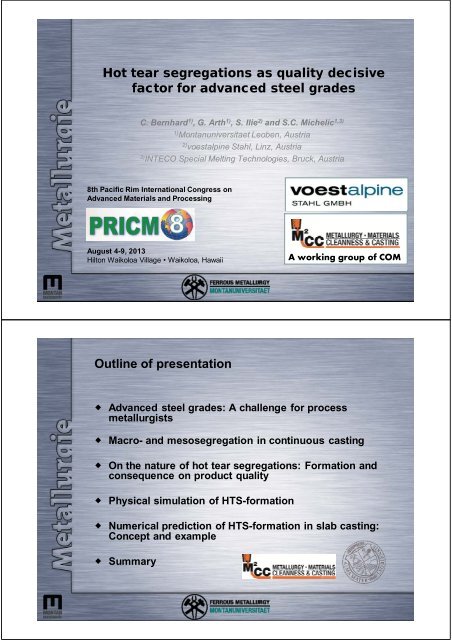Hot tear segregations as quality decisive factor for advanced steel ...
Hot tear segregations as quality decisive factor for advanced steel ...
Hot tear segregations as quality decisive factor for advanced steel ...
You also want an ePaper? Increase the reach of your titles
YUMPU automatically turns print PDFs into web optimized ePapers that Google loves.
<strong>Hot</strong> <strong>tear</strong> <strong>segregations</strong> <strong>as</strong> <strong>quality</strong> <strong>decisive</strong><strong>factor</strong> <strong>for</strong> <strong>advanced</strong> <strong>steel</strong> gradesC. Bernhard 1) , G. Arth 1) , S. Ilie 2) and S.C. Michelic 1,3)1)Montanuniversitaet Leoben, Austria2)voestalpine Stahl, Linz, Austria3)INTECO Special Melting Technologies, Bruck, Austria8th Pacific Rim International Congress onAdvanced Materials and ProcessingAugust 4-9, 2013Hilton Waikoloa Village • Waikoloa, HawaiiA working group of COMOutline of presentation Advanced <strong>steel</strong> grades: A challenge <strong>for</strong> processmetallurgists Macro- and mesosegregation in continuous c<strong>as</strong>ting On the nature of hot <strong>tear</strong> <strong>segregations</strong>: Formation andconsequence on product <strong>quality</strong> Physical simulation of HTS-<strong>for</strong>mation Numerical prediction of HTS-<strong>for</strong>mation in slab c<strong>as</strong>ting:Concept and example Summary
Quality pyramid: Incre<strong>as</strong>ing <strong>quality</strong> demands <strong>for</strong>state-of-the-art <strong>advanced</strong> <strong>steel</strong> gradesAdvanced <strong>steel</strong>s: low production, lower economic pressure <strong>for</strong> <strong>steel</strong> producerbut high ancd mostly complex <strong>quality</strong> demandsAPI, GO-Si-<strong>steel</strong>s, SEDDQ, Roller bearing <strong>steel</strong>s, SHSS, ...Multiph<strong>as</strong>e (DP, CP, TRIP), valve <strong>steel</strong>s , spring <strong>steel</strong>s ...Deep drawing <strong>steel</strong>s (DDQ), ....High-strength low-alloy (HSLA), Press hardening, (PH), ...Rein<strong>for</strong>cing <strong>steel</strong>s, structural <strong>steel</strong>s, ....Commodity <strong>steel</strong>: high production, high economic pressure <strong>for</strong> <strong>steel</strong>producer and low <strong>quality</strong> demandsPRICM8 Bernhard 3 Quality pyramid: Incre<strong>as</strong>ing <strong>quality</strong> demands <strong>for</strong>state-of-the-art <strong>advanced</strong> <strong>steel</strong> gradesAdvanced <strong>steel</strong>sAPI, GO-Si-<strong>steel</strong>s, SEDDQ, Roller bearing <strong>steel</strong>s, SHSS, ...Quality demands:- Strength within small tolerances- Highest <strong>steel</strong> cleanness on macro- but also microscopic level- Homogeneity and internal soundness- High surface <strong>quality</strong> (Decarburization, inclusions, …)- …Commodity <strong>steel</strong>Rein<strong>for</strong>cing <strong>steel</strong>s, structural <strong>steel</strong>s, ....Quality demand:- Minimum strengthPRICM8 Bernhard 4
Outline of presentation Advanced <strong>steel</strong> grades: A challenge <strong>for</strong> processmetallurgists Macro- and mesosegregation in continuous c<strong>as</strong>ting On the nature of hot <strong>tear</strong> <strong>segregations</strong>: Formation andconsequence on product <strong>quality</strong> Physical simulation of HTS-<strong>for</strong>mation Numerical prediction of HTS-<strong>for</strong>mation in slab c<strong>as</strong>ting:Concept and example Summary Importance of c<strong>as</strong>ting process <strong>for</strong> the homogeneityof the final product, example DP600, 210 mm slabPresslinger, H., S. Illie, A. Schiefermueller, A. Pissenberger, E.Parteder, and C. Bernhard: ISIJ, Vol. 46 (2006), No. 12, 1845-1851PRICM8 Bernhard 6
Macro- and Meso<strong>segregations</strong> in ContinuousC<strong>as</strong>ting of SlabsPorositiesV-type segregationSpot-like segregationCentre segregationPRICM8 Bernhard 7 Macro- and Meso<strong>segregations</strong> in ContinuousC<strong>as</strong>ting of Slabs, Example Mn in DP600Centre segregationPorositiesV-type segregationSpot-like segregationPresslinger, H., S. Illie, A. Schiefermueller, A. Pissenberger, E.Parteder, und C. Bernhard: 12 th ISIJ-VDEh-Seminar, November21-22 2005, Kitakyushu, Japan, 125-134PRICM8 Bernhard 8
Macro- and Meso<strong>segregations</strong> in ContinuousC<strong>as</strong>ting of Slabs, Mn in centre segregation of slabsPorositiesV-type segregationSpot-like segregationCentre segregationCentre segregation Mn Max/Mn Min4,03,53,02,52,01,51,00,50,0Soft reductionDP600/DP800TRIPHSLAAPIULCMC/HCHTS/SlabHTS/SSCT0,0 0,1 0,2 0,3 0,4 0,5 0,6 0,7 0,8 0,9 1,0Carbon content, wt.-%Illie, S. Et al.: <strong>steel</strong> research int. 78 (2007), No. 4.PRICM8 Bernhard 9 Macro- and Meso<strong>segregations</strong> in ContinuousC<strong>as</strong>ting of SlabsPorositiesV-type segregationSpot-like segregationCentre segregationSubsurface-off-corner „cracks“Triple-point „cracks“Halfway „cracks“,transversalHalfway „cracks“, longitudinalPRICM8 Bernhard 10
Macro- and Meso<strong>segregations</strong> in ContinuousC<strong>as</strong>ting of Slabs: <strong>Hot</strong> Tear SegregationSubsurface-off-corner cracksTriple-point cracksHalfway „cracks“,transversalHalfway „cracks“, longitudinalIlie, S.; Reiter, J.; Fluch, W.; Presslinger, H.; and C. Bernhard:6th European Continuous C<strong>as</strong>ting Conference, June 4-6 2008,Riccione, Italy, S. Paper – 122PRICM8 Bernhard 11Outline of presentation Advanced <strong>steel</strong> grades: A challenge <strong>for</strong> processmetallurgists Macro- and mesosegregation in continuous c<strong>as</strong>ting On the nature of hot <strong>tear</strong> <strong>segregations</strong>: Formation andconsequence on product <strong>quality</strong> Physical simulation of HTS-<strong>for</strong>mation Numerical prediction of HTS-<strong>for</strong>mation in slab c<strong>as</strong>ting:Concept and example Summary
On the nature of hot <strong>tear</strong> <strong>segregations</strong> (HTS) HTS <strong>for</strong>m during solidification inconsequence of an overcriticalstraining of the columnarsolidifying shell. HTS do not <strong>for</strong>m betweendendrites, <strong>as</strong> commonly attributed,they <strong>for</strong>m mainly along primarygrain boundaries.PRICM8 Bernhard 13 Formation of a hot <strong>tear</strong> segregation (HTS)Pierer, R. and C. Bernhard: AISTech 2010, Pittsburg, USAPRICM8 Bernhard 14
Concentration profile of S along a primary grain boundary,Example: 0.6% C, 0.005% S, orientation difference 30°C 0 : 0.6 %C0.5 %Si0.5 %Mn0.005 %P0.005 %Sh T : 500 Wm -2 K -130° angleMichelic, S.C. and C. Bernhard: TMS2013, San Antonio, USAPRICM8 Bernhard 15 Macro- and Meso<strong>segregations</strong> in ContinuousC<strong>as</strong>ting of SlabsCentre segregation Mn Max/Mn Min4,03,53,02,52,01,51,00,50,0DP600/DP800TRIPHSLAAPIULCMC/HCHTS/SlabHTS/SSCT0,0 0,1 0,2 0,3 0,4 0,5 0,6 0,7 0,8 0,9 1,0Halfway „cracks“, longitudinalSubsurface-off-corner cracksTriple-point cracksHalfway „cracks“,transversalCarbon content, wt.-%Ilie, S.; Reiter, J.; Fluch, W.; Presslinger, H.; and C. Bernhard: 6th European Continuous C<strong>as</strong>ting Conference,June 4-6 2008, Riccione, Italy, S. Paper – 122PRICM8 Bernhard 16
HTS result in …. … the <strong>for</strong>mation of undesirableph<strong>as</strong>es (commonly hard and brittleph<strong>as</strong>es like martensite). … inhomogeneous grain size in thefinal product. … the <strong>for</strong>mation of inclusions(Sulphides but also primary carbonitrides). … may even result in surfacedefects on cold-rolled band („glossystripes“).PRICM8 Bernhard 17Outline of presentation Advanced <strong>steel</strong> grades: A challenge <strong>for</strong> processmetallurgists Macro- and mesosegregation in continuous c<strong>as</strong>ting On the nature of hot <strong>tear</strong> <strong>segregations</strong>: Formation andconsequence on product <strong>quality</strong> Physical simulation of HTS-<strong>for</strong>mation Numerical prediction of HTS-<strong>for</strong>mation in slab c<strong>as</strong>ting:Concept and example Summary
In-situ simulation of HTS - <strong>for</strong>mation Parameters: Steel composition,solidification time, strain, strain rate.Pierer, R. and C. Bernhard: AISTech 2010, Pittsburg, USAPRICM8 Bernhard 19 In-situ simulation of HTS - <strong>for</strong>mation Results confirm proposed mechanism: In contr<strong>as</strong>t to thecommon opinion no clear boundary between „Cracks“ and „Nocracks“ exists. An incre<strong>as</strong>ing strain results in an incre<strong>as</strong>ingnumber of HTS and an more pronounced enrichment.Bernhard, C. and R. Pierer:Solidification 2007, Sheffield, UKPRICM8 Bernhard 20
In-situ simulation of HTS - <strong>for</strong>mation The SSCT-experiment allows to <strong>as</strong>sign the HTS-phenomenon to acertain range of solid fractions, commonly in the range of 0,96 – 1,0.Distance from surface, mmAccumulated strain, %Dierer, F.: Bachelor-thesis, MU-Leoben, 2013PRICM8 Bernhard 21 In-situ simulation of HTS - <strong>for</strong>mation The SSCT-experiment allows to <strong>as</strong>sign the HTS-phenomenon to acertain range of solid fractions, commonly in the range of 0,96 – 1,0.Distance from surface, mmAccumulated strain, %+ 79 ppm BDierer, F.: Bachelor-thesis, MU-Leoben, 2013PRICM8 Bernhard 22
Outline of presentation Advanced <strong>steel</strong> grades: A challenge <strong>for</strong> processmetallurgists Macro- and mesosegregation in continuous c<strong>as</strong>ting On the nature of hot <strong>tear</strong> <strong>segregations</strong>: Formation andconsequence on product <strong>quality</strong> Physical simulation of HTS-<strong>for</strong>mation Numerical prediction of HTS-<strong>for</strong>mation in slab c<strong>as</strong>ting:Concept and example SummaryHTS-Analysis of C<strong>as</strong>ting Processes by Numerical and Physical SimulationBoundary conditionsHeat transfer (Mold)Me<strong>as</strong>urement, ModelsC<strong>as</strong>tingmachineLayout, <strong>steel</strong> grades,c<strong>as</strong>ting parametersPre-ProcessingThermophysicalpropertiesCATD-packagesHeat transfer(Secondary cooling)Nozzle me<strong>as</strong>uring standMetallurgical modelse.g. <strong>Hot</strong> <strong>tear</strong>ing:- Prediction of accumulated strain- Prediction of HTS-propability1D- and 2Dsolver,transientmodelsCommercialsoftwarepackagesPostprocessingPierer, R., S.C. Michelic and C. Bernhard: AISTech 2012, Atlanta, USA
C<strong>as</strong>e study: slab c<strong>as</strong>ting of two <strong>steel</strong> grades, hard and soft coolingin the first secondary cooling zoneSteel AC Si Mn P S N Cr Ni0,17 0,43 1,54 0,015 0,007 0,0001 0 0Steel BC Si Mn P S N Cr NiSteel 0,15A; Hardcooling 0,015vs. Softcooling 1,109 0,008 0,007 0,0001 Steel B; 0Hardcooling 0vs. Softcooling120120Shell Thickness [mm]100806040Steel AShell Thickness [mm]100806040Steel B2020Stahl A - Hard - 0 MisAligStahl A - Soft - 0 MisAlig00,0 0,1 0,2 0,3 0,4 0,5 0,6 0,7 0,8 0,9 1,0Accumulated Strain [%]Stahl B - Hard - 0 MisAligStahl B - Soft - 0 MisAlig00,0 0,1 0,2 0,3 0,4 0,5 0,6 0,7 0,8 0,9 1,0Accumulated Strain [%]PRICM8 Bernhard 25Outline of presentation Advanced <strong>steel</strong> grades: A challenge <strong>for</strong> processmetallurgists Macro- and mesosegregation in continuous c<strong>as</strong>ting On the nature of hot <strong>tear</strong> <strong>segregations</strong>: Formation andconsequence on product <strong>quality</strong> Physical simulation of HTS-<strong>for</strong>mation Numerical prediction of HTS-<strong>for</strong>mation in slab c<strong>as</strong>ting:Concept and example Summary
ConclusionsTolerance <strong>for</strong> HT and HTS<strong>Hot</strong> <strong>tear</strong>ing sensitivity of <strong>steel</strong>s> 2/3 of theproduced<strong>steel</strong>s areinsensitive <strong>for</strong>HT and HTSHTS-<strong>for</strong>mationresults fromsingular eventsHTS-critical<strong>steel</strong>gradesExamples:Medium manganese<strong>steel</strong>s (0.1%C, 5% Mn)M³ HSLA (Mo, Nb, Ni, Al)B-alloyed <strong>steel</strong>s,….Incre<strong>as</strong>ing complexity of <strong>quality</strong> demands,Incre<strong>as</strong>ing content of „critical“ elements in the <strong>steel</strong>PRICM8 Bernhard 27<strong>Hot</strong> <strong>tear</strong> <strong>segregations</strong> <strong>as</strong> <strong>quality</strong> <strong>decisive</strong><strong>factor</strong> <strong>for</strong> <strong>advanced</strong> <strong>steel</strong> gradesC. Bernhard 1) , G. Arth 1) , S. Ilie 2) and S.C. Michelic 1,3)1)Montanuniversitaet Leoben, Austria2)voestalpine Stahl, Linz, Austria3)INTECO Special Melting Technologies, Bruck, Austria8th Pacific Rim International Congress onAdvanced Materials and ProcessingAugust 4-9, 2013Hilton Waikoloa Village • Waikoloa, HawaiiA working group of COM




